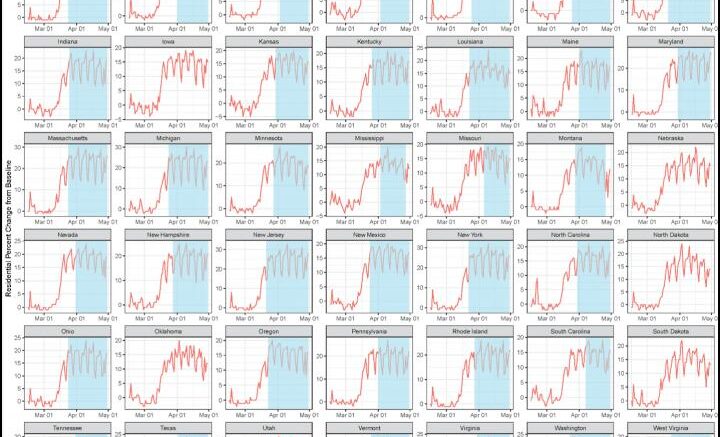States' residential mobility over time with highlighted period of government stay-at-home order. The red line represents the state-wide mobility data generated by Google (a composite of all the counties within that state). Blue color denotes the period and duration of government-mandated social distancing. Courtesy of American Journal of Preventive Medicine
Quantifying the mitigating impact of social distancing on the spread of COVID-19 is critical for evaluating the efficacy of social restrictions and informing future health policy decisions. While most studies have used government stay-at-home dates in their models, new research finds that individuals actually changed their behavior in reaction to the presence of COVID-19 in their state a median 12 days before a government lockdown. This underestimates the impact social distancing has in controlling the spread of the virus. The research, appearing in the American Journal of Preventive Medicine, examines sociodemographic variables as well and finds that individual behavior across certain groups may partially account for the disproportionate impact of COVID-19 on vulnerable communities in the United States.
"To many, social distancing and government stay-at-home orders are interlinked," explained corresponding author Moustafa Abdalla, PhD, of Harvard Medical School. "Historically, however, public health behavior has varied dramatically from government mandates, especially along sociodemographic lines. By using government dates as proxies for individual behavior, we miss the variation in adoption of social distancing practices - which, as we discovered, can partially account for the higher burden of disease observed in vulnerable communities. We shouldn't be too quick to simplify individual or population behavior with government dates."
The investigators used cell phone data from 1,124 counties across 42 states to quantify the time between when COVID-19 infections became prevalent in a state (defined as 10 confirmed cases) and when individuals began to change their behavior, compared with the date of a government stay-at-home order. A systematic review of the literature was used to assess the underestimation of the impact of social distancing on COVID-19 infections when measured by government stay-at-home dates instead of mobility data. A machine-learning model of sociodemographic variables was used to explain the variation in county-level delays in social distancing.
Across all 42 states with stay-at-home orders, individuals began to spend more time at home before the government lockdowns and continued to stay at home after lockdowns were lifted. Individuals began to socially distance a median of five days after COVID-19 became locally prevalent. Overall, people began to socially distance 12 days before state orders to do so. Researchers noted that studies using only government data found a 10.2 percent decrease related to social distancing in the number of daily cases compared with an 18.6 percent reduction using mobility data; government data captured only 55 percent of the true impact of social distancing orders.
The COVID-19 pandemic has highlighted and exacerbated many of the health disparities that exist in America. The investigators looked at 43 sociodemographic variables and found that 23 were significantly associated with a delay in individual social distancing behavior. Counties with less education, larger minority populations, and more non-English speakers were most strongly associated with a delay in social distancing. Investigators hypothesize that the higher case burden and mortality observed among these vulnerable communities may be partly explained by these findings. Reasons underlying the hesitancy to social distance might be related to a distrust of science, lower medical literacy, or the lack of non-English language educational resources, but further research is needed.
The investigators observe that their research demonstrates that decisions to impose or lift social restrictions may be partly based on previous models of social distancing efficacy that have not properly accounted for testing capacity or social mobility predating government interventions. "Future investigation on the effects of social distancing should not solely rely on policy time points, but instead should take into account predated awareness and action," commented Abdalla.

Be the first to comment on "State-Reported Data Underestimate the True Impact of COVID-19 Social Distancing"